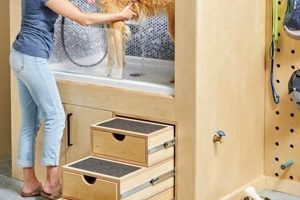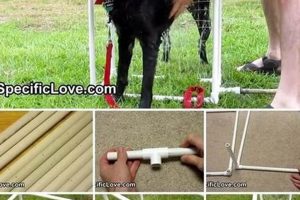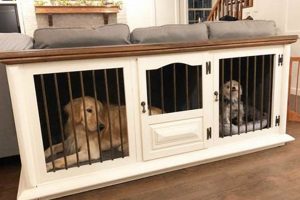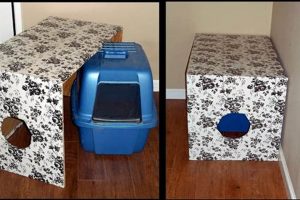The construction of a customized sleeping platform for canines, integrated with a stepped access system, addresses the needs of small, aging, or mobility-impaired animals. These elevated resting spaces, often handcrafted, provide comfort and ease of access, reducing strain on joints during ascent and descent. For instance, a small dog might benefit from a platform bed only a few inches off the ground with two or three gentle steps leading up to it.
Such structures offer several advantages. They provide a secure and comfortable personal space for the animal, contributing to its overall well-being. The inclusion of steps mitigates the risk of injury associated with jumping onto or off of higher surfaces, especially important for breeds prone to back problems. Historically, owners have sought creative solutions to enhance their pets’ quality of life; this is a modern iteration of that care.
The following sections will detail materials typically utilized, construction methods, and considerations for customization to suit individual pet size, needs, and owner preferences. This includes examining suitable bed types and step designs and the integration of safety features.
Construction Considerations
The following points detail important aspects to consider when undertaking such a project, ensuring both functionality and safety for the animal companion.
Tip 1: Material Selection: Prioritize durable, non-toxic materials for both the bed frame and the step structure. Solid wood or plywood are suitable choices, but must be free of harmful chemical treatments. Fabric selections for cushioning should be resistant to wear and easily cleaned.
Tip 2: Step Height and Depth: The riser height and tread depth of the steps should be carefully calculated based on the dog’s size and physical capabilities. A shallower depth and lower rise are crucial for smaller or senior dogs with limited mobility.
Tip 3: Structural Stability: Ensure the stability of the entire construction. Reinforce joints with screws, dowels, or metal brackets to prevent wobbling or collapse. The platform bed must adequately support the animal’s weight.
Tip 4: Surface Traction: Apply a non-slip coating or attach textured material to the surface of each step. This prevents accidental slips and falls, promoting confidence during use. Carpet remnants or rubberized mats can be effective.
Tip 5: Bedding Comfort: Select appropriate bedding for the platform, considering the dog’s preferences and any specific orthopedic needs. Memory foam or supportive fiberfill options offer enhanced comfort and pressure relief.
Tip 6: Safety Railings (Optional): Consider adding small, unobtrusive railings to the sides of the steps, particularly for older or visually impaired dogs. These can provide additional security and prevent accidental falls.
Tip 7: Finishing Touches: Sand all edges and surfaces to eliminate sharp corners or splinters. Apply a non-toxic sealant or paint to protect the wood and enhance its appearance.
Adhering to these construction guidelines promotes a safe, comfortable, and functional structure, tailored to the specific needs of the animal.
The subsequent section addresses potential design variations and customization options to personalize the final product.
1. Dimensions
The dimensions of a handcrafted sleeping platform with integrated steps for canines are critically linked to the project’s overall success and the animal’s well-being. Incorrectly sized components negate the bed’s intended purpose and can pose safety hazards. The dimensions encompass the platform’s width, length, and height, as well as the step’s riser height, tread depth, and overall number. Accurate measurement and careful calculation of these parameters are paramount.
For example, a Great Dane requires a significantly larger sleeping surface than a Chihuahua. Similarly, a Dachshund, predisposed to intervertebral disc disease, benefits from lower steps with shallower treads to minimize spinal strain. A poorly designed step height, even if aesthetically pleasing, might render the entire structure unusable, or, worse, lead to falls and injuries. The bed’s overall height must be sufficient to provide a comfortable resting space, yet low enough to facilitate easy access via the steps. Understanding the breed-specific characteristics and individual dog’s physical limitations directly informs the dimensional design.
In conclusion, the dimensional specifications are not arbitrary; they are a functional imperative. An ill-proportioned platform with steps renders the entire project ineffective and potentially dangerous. Therefore, meticulous attention to detail, driven by a thorough understanding of the dog’s individual needs and limitations, is the foundation of a successfully crafted and safe pet structure. The careful dimensional planning ensures the project’s functionality, safety and value.
2. Material Safety
Material safety is a paramount consideration in the construction of a customized canine sleeping platform with integrated steps. The selection of appropriate, non-toxic materials directly impacts the animal’s health and well-being. This becomes especially pertinent given that dogs may chew, lick, or otherwise interact with the bed’s components.
- Wood Treatment Chemicals
Many commercially available wood products are treated with chemicals to prevent decay, insect infestation, or fire. These treatments may contain volatile organic compounds (VOCs) or other substances harmful if ingested or inhaled over prolonged periods. Selecting untreated lumber or opting for naturally resistant wood species, followed by the application of pet-safe sealants, mitigates this risk.
- Fabric Composition and Dyes
The fabrics used for cushioning and covering the bed frame should be selected with care. Synthetic fabrics may release harmful chemicals or irritants, while certain dyes can be toxic if ingested. Natural, undyed fabrics like cotton, linen, or hemp are generally safer choices. Certifications such as Oeko-Tex Standard 100 indicate that a fabric has been tested for harmful substances.
- Adhesives and Fasteners
Adhesives used in joining wood components must be non-toxic and low-VOC. Conventional wood glues often contain formaldehyde, a known carcinogen. Similarly, fasteners such as screws and nails should be free of lead or other heavy metals that could leach into the environment. Stainless steel fasteners are a durable and inert option.
- Surface Finishes and Sealants
Surface finishes, paints, and sealants protect the wood and enhance its appearance, but many contain harmful chemicals. Water-based, low-VOC paints and sealants are available and should be prioritized. These options minimize off-gassing and reduce the risk of exposure to toxic fumes.
The integration of these material safety considerations in the design and construction of a customized canine bed directly influences the animal’s health and longevity. A commitment to utilizing non-toxic and pet-safe materials is essential for responsible pet ownership and ensuring the well-being of the animal.
3. Step stability
Step stability is a critical design and construction element in any do-it-yourself canine sleeping platform incorporating stairs. The stability directly correlates to the pet’s safety and willingness to utilize the structure. Insufficient stability negates the benefits of the stairs, potentially leading to injury and rendering the entire project counterproductive.
- Joint Reinforcement Techniques
The connections between step components and the bed frame require robust reinforcement. Screws alone may be insufficient, particularly with repeated use. Employing wood glue in conjunction with screws, dowels, or metal brackets enhances joint strength and resistance to shear forces. The type of joint (e.g., mortise and tenon, dovetail) also significantly influences stability. These techniques minimize wobbling and prevent premature structural failure.
- Weight Distribution Considerations
The distribution of the dog’s weight across the steps must be accounted for in the design. A single, centrally located support beam may be inadequate for larger breeds. Multiple vertical supports, strategically positioned beneath each step, distribute the load more evenly and prevent sagging or bending. The material’s inherent strength (e.g., wood type and thickness) must be appropriate for the anticipated weight.
- Base Stability and Floor Contact
The base of the structure must maintain firm and level contact with the floor. Uneven flooring introduces instability and increases the risk of tipping. Adjustable leveling feet can compensate for minor irregularities in the floor surface. Additionally, non-slip pads affixed to the base enhance grip and prevent movement during use.
- Material Selection and Rigidity
The choice of materials directly impacts the steps’ overall rigidity. Plywood, while cost-effective, may deflect under load if not properly supported. Solid hardwood offers superior stiffness and resistance to bending. The material’s thickness must be adequate to withstand the compressive and shear forces generated during use. A thicker material minimizes flex and enhances the overall sense of stability.
The integration of these stability considerations is vital for the project’s success. A stable step system ensures the canine occupant feels secure and confident while using the structure. This, in turn, promotes the bed’s consistent utilization and minimizes the risk of accidents. Therefore, thorough planning and robust construction techniques are essential for delivering a safe and functional sleeping platform with stairs.
4. Bedding comfort
Bedding comfort represents a critical component in the design and functionality of a customized canine sleeping platform with steps. The selection of appropriate bedding directly impacts the dog’s willingness to utilize the structure, as well as their overall physical well-being. A well-designed bed frame and stable steps are rendered less effective if the bedding surface is uncomfortable, unsupportive, or unsuitable for the animal’s specific needs. For instance, a senior dog with arthritis requires a different bedding solution compared to a young, active animal.
Examples of bedding choices include orthopedic foam mattresses designed to alleviate pressure on joints, plush fabrics for warmth and comfort, and cooling gel pads for warmer climates or breeds prone to overheating. The size and shape of the bedding must also correspond to the dimensions of the sleeping platform. A bed that is too small will not provide adequate support, while one that is too large may create a tripping hazard on the steps. The ease of cleaning and maintenance of the bedding material is another practical consideration, as canine beds are prone to accumulating dirt, hair, and odors.
In summary, bedding comfort is not merely an aesthetic detail, but an essential functional element. A carefully chosen bedding solution transforms a basic structure into a supportive and inviting resting space. Overlooking bedding comfort can diminish the overall benefits and usability of a customized canine sleeping platform with steps. Therefore, diligent attention to this aspect is vital for optimizing the animal’s comfort and ensuring the structure’s long-term utility.
5. Dog's Mobility
Canine mobility, defined as the ability to move freely and without pain, is a central consideration in the design and utility of a handcrafted elevated sleeping platform with integrated steps. Impaired mobility, whether due to age, injury, or breed-specific predispositions, directly impacts the animal’s quality of life. The decision to construct such a structure is often driven by a desire to mitigate the challenges posed by reduced mobility.
- Age-Related Decline
As dogs age, they often experience a decline in joint health and muscle mass, leading to arthritis and decreased mobility. Elevated sleeping platforms with gradual steps provide a gentler alternative to jumping onto and off of furniture, reducing strain on aging joints and promoting comfortable rest.
- Breed-Specific Predispositions
Certain breeds are predisposed to musculoskeletal conditions that impact mobility. Dachshunds, for example, are prone to intervertebral disc disease, while larger breeds like Great Danes are susceptible to hip dysplasia. Step design and platform height must accommodate these specific vulnerabilities to minimize discomfort and prevent further injury.
- Post-Surgical Recovery
Following orthopedic surgery, dogs often require a controlled environment to facilitate healing and prevent re-injury. A strategically designed platform with steps can limit strenuous activity and provide a secure resting space during the recovery period, aiding in the rehabilitation process.
- Physical Limitations and Assistance
Severe physical limitations may necessitate specialized step designs or even ramps in place of steps. Considerations should include the animal’s stride length, balance, and overall strength. Some dogs may require harnesses or other assistive devices in conjunction with the platform and steps to ensure safe and comfortable access.
The multifaceted relationship between canine mobility and the design of elevated sleeping platforms underscores the importance of individualized assessment. Factors such as age, breed, medical history, and individual physical capabilities must inform the construction process to ensure the resulting structure effectively addresses the dog’s specific needs and promotes optimal well-being. The ultimate goal is to enhance the animal’s quality of life by providing a safe, comfortable, and accessible resting space that accommodates their unique mobility challenges.
Frequently Asked Questions
This section addresses common inquiries concerning the design, construction, and implementation of handcrafted canine sleeping platforms incorporating stairs. The information provided is intended to offer clarity and guidance based on best practices.
Question 1: What is the optimal angle for the staircase relative to the dog bed?
The angle should not exceed 45 degrees to minimize strain on the dog’s joints during ascent and descent. A shallower angle is preferable, particularly for breeds predisposed to spinal issues.
Question 2: What type of wood is most suitable for this project?
Hardwoods such as maple, oak, or birch offer superior durability and resistance to wear. Untreated lumber is recommended to avoid exposure to harmful chemicals.
Question 3: How can step slippage be prevented?
Applying a non-slip coating, such as rubberized paint or textured adhesive strips, to each steps surface significantly enhances traction and reduces the risk of falls.
Question 4: How often should the bedding be cleaned?
The bedding should be cleaned at least once per week to maintain hygiene and prevent the accumulation of allergens or parasites. More frequent cleaning may be necessary for dogs with skin conditions.
Question 5: What is the recommended weight capacity for the structure?
The weight capacity should exceed the dog’s weight by a factor of at least two to account for dynamic forces during use. Proper structural reinforcement is essential to ensure stability.
Question 6: How can the structure be adapted for a visually impaired dog?
Adding tactile markers to the edges of each step and along the perimeter of the bed frame can assist visually impaired dogs in navigating the structure safely.
These FAQs provide a foundational understanding of key considerations when undertaking such a project. Thorough planning and adherence to best practices contribute to a safe and functional outcome.
The subsequent section will discuss potential safety hazards.
Conclusion
The preceding analysis has elucidated the critical considerations involved in the design and construction of “diy dog bed with stairs.” Dimensions, material safety, step stability, bedding comfort, and accommodation of canine mobility were identified as paramount factors influencing the project’s success. Failure to adequately address these elements compromises the structure’s functionality and may jeopardize the animal’s well-being.
Owners considering this undertaking must prioritize meticulous planning and adherence to established construction principles. The resulting structure should not only provide a comfortable resting space but also serve as a safe and accessible aid for animals facing mobility challenges. Ongoing evaluation of the design’s efficacy and prompt rectification of any emerging issues remain essential to ensuring the animal’s continued safety and comfort.







